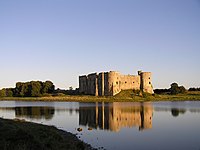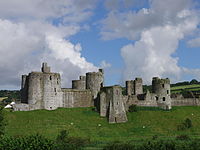House of Dinefwr


The Royal House of Dinefwr was a
History
With the death of
The Dinefwr dynasty under King
The Dinefwrs would rule in Deheubarth until their conquest by the Plantagenet kings in the 13th century. This branch would compete with the House of Aberffraw for supremacy and influence in Wales throughout the 10th, 11th and 12th centuries, with the Kingdom of Powys variously ruled between them. Eventually, a cadet branch of the House of Dinefwr would establish itself in Powys by the mid-11th century, designating themselves as the House of Mathrafal after the castle there named Mathrafal Castle. This dynasty will be the last with a native Welsh Prince of Wales before its annexation into the Kingdom of England.[6]
During the 12th century, Lord Rhys's father, Prince
Other important members of the Dinefwr family were
One of Rhys ap Gruffydd's descendant,
Ancestral seat
The ancestral seat of the dynasty was
Another notable member was
.She was also a first cousin of the
As Spanish law allowed the inheritance of estates and titles in the female line, Anne became Duchess after the death of her brother
The most recent Baron Dynevors are Richard Rhys, 9th Baron Dynevor (b. 1935) and Hugo Rhys, 10th Baron Dynevor (b. 1966). The heir presumptive is the present holder's second cousin, Robert David Arthur Rhys (b. 1963) and afterwards, Robert's son Edward (b. 2002).
The dynasty also captured many castles throughout the centuries such as Cardigan Castle, Kidwelly Castle, Rhuddlan Castle, Carmarthen Castle, Laugharne Castle, Llandovery Castle, Swansea Castle, Aberystwyth Castle, Oystermouth Castle, Llansteffan Castle, Tenby Castle, Aberavon Castle, St Clears Castle, Aberdyfi Castle, Cilgerran Castle, Builth Castle, Nevern Castle, Painscastle, Colwyn Castle, New Radnor Castle.
Members

Before the Norman Conquest of England
- Laws of Hywel Dda, and did a pilgrimage to Romelater in his life
- Edgar the Peaceful, a member of the Royal House of Wessex
- Kingdom of Mercia
- Maredudd ab Owain ab Edwin, Welsh prince, he fought against the Normans and supported the English magnate Eadric the Wild in his conquest, was awarded lands in England as a result
- Rhys ab Owain, King of Deheubarth, he fought against the King of Gwynedd and Powys, he was killed at war by Prince Caradog ap Gruffydd, he was implicated in the killing of King Bleddyn ap Cynfyn
- Gwgon, King of Ceredigion, with his son they conquered the Kingdom of Dyfed
- Einion ab Owain, Welsh prince, he fought with King Iago ab Idwal against the Irish and Vikings, and later against Ælfhere, Ealdorman of Mercia, he was in conflict with Edgar, King of England
- Llywelyn ap Seisyll, King of the Britons, killed prince Aeddan ap Blegywryd, and was featured in Brut y Tywysogion and Annals of Ulster, his sons died fighting at the Battle of Mechain
- Rhain the Irishman, King of Dyfed, featured in the Annales Cambriae, possible pretender to the throne, killed by King Llywelyn ap Seisyll, his body was not discovered
- Rhodri ap Hywel, King of Deheubarth, son of the King of the Britons, co-ruled with Edwin and Owain, lost land to the Aberffraw dynasty, and was defeated at a Battle in Llanrwst
After the Norman Conquest of England
- Rhys ap Tewdwr, King in Southern Wales, made an agreement with William the Conqueror for his Kingdom, was later forced to flee to Ireland, came back with a fleet and attacked the Royal House of Mathrafal
- Empress Matilda, he refused to pay homage to King Stephen of Englandin London
- House of Fitzgerald, and former Constable of Pembroke Castle
- Carreg Cennen castle, was summoned by King Henry Plantagenet to pay him homage with Malcolm IV of Scotland
- Gwenllian, daughter of Tudor dynasty
- Angharad, daughter of Rhys ap Gruffydd, married to William FitzMartin, Lord of Cemais, his castle was taken by his father-in-law and given to his son, her father was the most powerful man in Wales
- Annest ferch Rhys, daughter of King of Mann and the Isles
- Philip Augustus, 1st King of France
- John of England, he then seized Cilgerran Castle but later lost it to William Marshal, 1st Earl of Pembroke
- Vikingfleet against the Normans
- Cadell ap Gruffydd, Prince of Deheubarth, captured Llansteffan Castle and Carmarthen Castle, was attacked and injured by the Normans during a hunt, he left Wales for a pilgrimage to Rome
- Maredudd ap Gruffydd, prince in South-West Wales, fought with his half-brother, Cadell, against the Normans, expelling them from the Kingdom of Ceredigion, he became King after his brother left Wales for Rome
- Edward Longshanks, and lived at Dryslwyn Castle, he later rebelled and was executed for treason at York, his son was imprisoned at Bristol Castle
- Rhys Gryg, Welsh prince, fought against Baron Falkes de Bréauté, his wife was the sister of Gilbert de Clare, 5th Earl of Gloucester, a signatory of Magna Carta, his widow remarried to Richard Plantagenet, King of the Romans
- Maredudd ap Rhys Gryg, was in the wardship of Gilbert Marshal, 4th Earl of Pembroke, his aunt was Countess Isabel Marshal, the great grandmother of Robert the Bruce, King of Scots
- Rhys Mechyll, Welsh prince, married to Matilda de Braose (Deheubarth), his sole heiress married into the House of Talbot and assumed the arms of the House of Dinefwr, she was related to the Royal House of Stuart
After the Edwardian Conquest of Wales
- Habsburgs
- Margaret Beaufort, the grandmother of Henry VIII, they both served Queen Catherine of Aragon and Arthur, Prince of Wales
- Cardinal Thomas Wolsey
- Agnes Rice, 2nd wife of Baron Ferdinand de Rothschild of Waddesdon Manor
- William Talbot, Earl Talbot, 1st Baron Dynevor, was Lord High Steward to King George III, his father-in-law was Secretary to John Churchill, 1st Duke of Marlborough of Blenheim Palace
- George Rice, 3rd Baron Dynevor, son of George Rice, Lord Commissioner of the Board of trade to Thomas Pelham-Holles, 1st Duke of Newcastle, the Prime Minister of Great Britain
- George Rice-Trevor, 4th Baron Dynevor, married to a daughter of General Lord FitzRoy, son of Augustus, 3rd Duke of Grafton, Prime Minister of Great Britain and descendant of King Charles II of the House of Stuart
- Selina Rice-Trevor (1836–1918), married to William Pakenham, 4th Earl of Longford, a General during the Indian Rebellion and Crimean War of Napoleon III of the House of Bonaparte
- House of Villiers, the family of the Dukes of Buckingham
- Duchess of Ciudad Rodrigo, daughter of Arthur Wellesley, 5th Duke of Wellington, and granddaughter of Arthur Wellesley of Apsley House, Prince of Waterloo and Duke of Victoria
Castles
-
Llansteffan Castle, captured by Prince Cadell ap Gruffydd
-
Lord Rhys
-
Ruins of Dinefwr Castle, seat of the Royal House of Dinefwr, in the Kingdom of Deheubarth
-
Sir Rhys ap Thomas
-
Laugharne Castle, seized by Lord Rhys, along with St Clears and Llansteffan
-
Lord Rhys
-
Newton House, Llandeilo, seat of the Baron Dynevors
Sources
- ^ Professor Thomas Jones Pierce. "RHODRI MAWR ('the Great') (died 877), king of Gwynedd, Powys, and Deheubarth". Dictionary of Welsh Biography. National Library of Wales. Retrieved 2022-10-31.
- ^ Thomas Peter Ellis. "Welsh Tribal Law and Custom In The Middle Ages, Volume 1". McMaster University. p. 356. Retrieved 2022-10-31.
- ISBN 9780708324479. Retrieved 2022-10-31.
- ^ Sir John Edward Lloyd (1912). "A History of Wales from the Earliest Times to the Edwardian Conquest". archive.org. Longmans, Green. Retrieved 2022-10-31.
- ^ "HYWEL DDA (Hywel the Good) (died 950), king and legislator". Dictionary of Welsh Biography. National Library of Wales. Retrieved 2022-10-31.
- ^ "RCAHMW: In the steps of Owain Glyndwr". rcahmw.gov.uk. Royal Commission on the ancient and historical monuments of wales. Retrieved 2022-10-31.
- ISBN 9780708324479. Retrieved 2022-10-31.
- ^ Rees, D. pp. 38–39.
- ^ Ralph A. Griffiths (1991). "King and Country England and Wales in The Fifteenth Century". Bloomsbury Academic. Retrieved 2022-10-31.
- ^ a b "RHYS ap GRUFFYDD or ' Syr RHYS ' (died 1356), nobleman". Dictionary of Welsh Biography. National Library of Wales. Retrieved 2022-10-31.
- ^ Ralph A. Griffiths (1991). "King and Country England and Wales in The Fifteenth Century". Bloomsbury Academic. Retrieved 2022-10-31.
- ^ Oman, Sir Charles W. C. (1998), History of the Art of War in the 16th Century, p. 295
- ^ Hall 1809, p. 542; Grafton, Richard, Chronicle at Large, vol. 1 (1809), pp . 256, 257–8
- ^ a b "RHYS ap THOMAS, Sir (1449 - 1525), the chief Welsh supporter of Henry VII". Dictionary of Welsh Biography. National Library of Wales. Retrieved 2022-10-31.
- ^ Griffiths, Ralph. The Principality of Wales in the Later Middle Ages.
- ^ "Dinefwr Park". www.nationaltrust.org.uk. Archived from the original on 2015-12-11. Retrieved 2022-10-31.
- ^ "Dinefwr Park". www.nationaltrust.org.uk. Archived from the original on 2015-12-11. Retrieved 2022-10-31.
- ^ "Dinefwr Park". www.nationaltrust.org.uk. Archived from the original on 2015-12-11. Retrieved 2022-10-31.
- ^ What is a Second Cousin, Common grandfather is Arthur Wellesley, 4th Duke of Wellington. Lady Pamela through Lord Richard Wellesley, son of the 4th Duke, Lady Anne through the 5th Duke, and the 9th Duke through the 7th Duke. Lady Pamela married Charles Grant, son of Lady Sybil Grant
- ^ Pamela Berry (née Wellesley); Charles Robert Archibald Grant, 1 of 5 portraits of Charles Robert Archibald Grant, National Portrait Gallery, St Martin's Place, London
- ISBN 9780297856344.
- ^ George Edward Cockayne (1998). The Complete Peerage of England, Scotland, Ireland, Great Britain, and the United Kingdom: Addenda and Corrigenda. St. Catherine Press, Limited. p. 627.
- ISBN 9780297856344.
- ^ George Edward Cockayne (1998). The Complete Peerage of England, Scotland, Ireland, Great Britain, and the United Kingdom: Addenda and Corrigenda. St. Catherine Press, Limited. p. 627.
- Davies, John (2007). History of Wales. Penguin Books. London
- Castles of Wales by John Davis, 6 apr 2022 - 252 pages
- The Royal Families in Europe V by Lars Ulwencreutz - 742 pages
- Gruffydd ap Nicholas and the rise of the House of Dinefwr, National Library of Wales, journal, page 256
- The Longhunters: A Report on the History and Family of William Blevins Sr. of Virginia by Leslie W. Blevins Jr. apr 2012 · Xlibris Corporation, - 210 pages
- Cardiganshire County History Volume 2: Medieval and Early Modern Cardiganshire (The Cardiganshire County History) by Geraint H. Jenkins, - 921 pages









